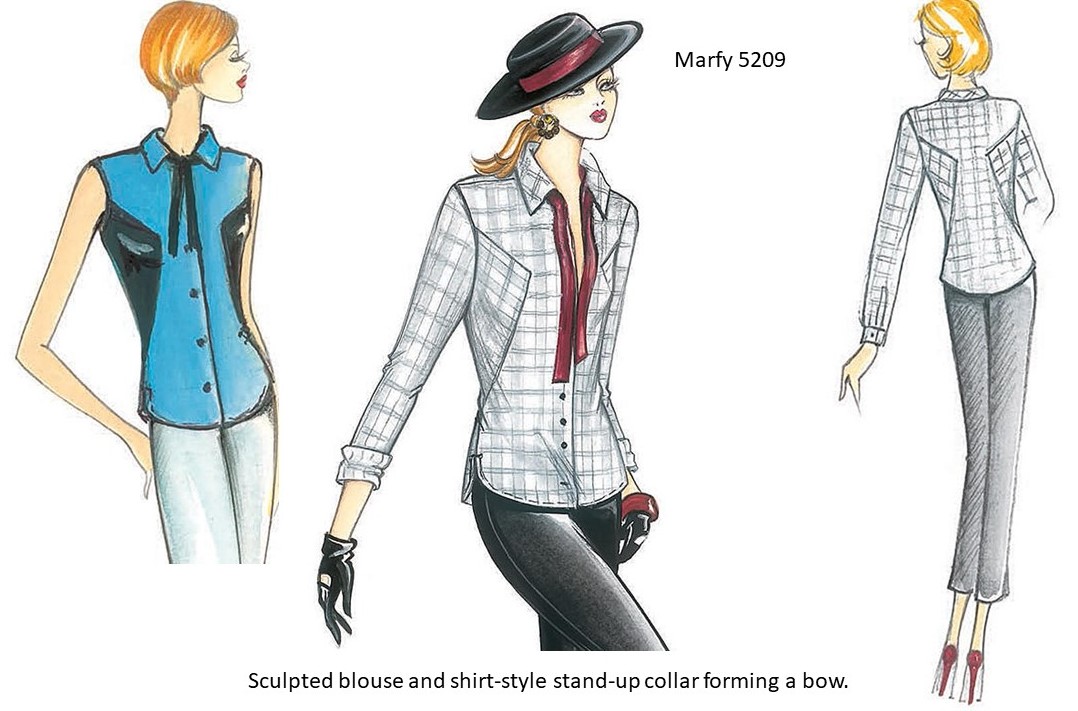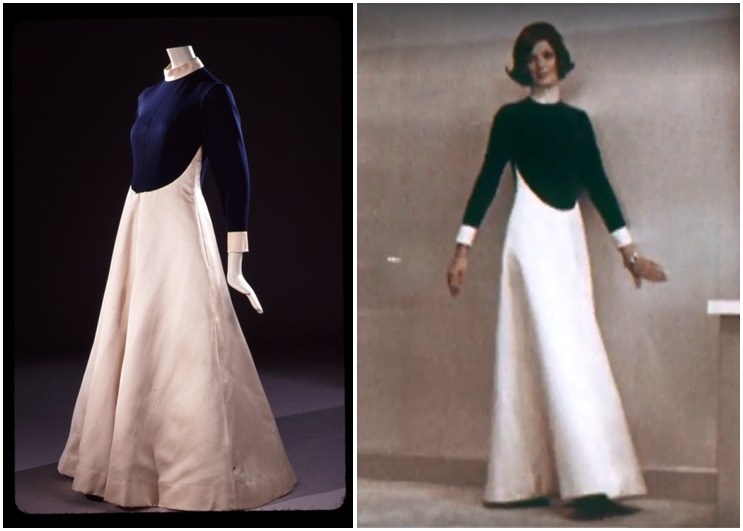 |
To View in your browser, click here
October 14, 2022
Rotating darts is one of my favorite ways to get a variation on your core pattern, with some very remarkable results. But there are some rules to this that are helpful to get you to those remarkable results.
Rotating darts rotate (well, duh!), but they have to have a point to rotate on. That point is always one of the apex points around the body, plus one! The most familiar ones are:
Bust
Hip
Stomach
Fanny
Shoulder Blade
Plus One that is not an apex, but the opposite, but you must take into consideration: The Waist.
So when you have a bodice dart in your core pattern that is a combination dart, there are some factors that you have to consider when you get ready to rotate that dart. When a dart is specific to one apex point (like a bust dart or a waist dart or a hip dart) then rotating that dart is easy - rotate on the apex point, and it's done. When a dart is a combination of apex points, then you need to make some special rules to make the dart fit when you rotate it.
A dart has to have a beginning and an ending (Duh!), but this is more important than just stating the obvious. What this means is that you can't start a traditional dart at 1" and end in a dart point in the middle of a garment - well you can, but it's a pleat, not a dart. What you can't do is make a dart flat at a pleat point.
Here's what I mean.

A bust/waist/hip dart fits the bust, waist and hip. This is a typical double-pointed dart - it starts at one "point" and ends at another with the bulk of the dart being in the middle. If you want to If you want to rotate only the bust part, where do you rotate this dart to make it fit?...the bust or the hip?

See the problem in a combination dart? BTW most combination darts are double-pointed. They have two dart points, therefore they are fitting more than one "point."
But there are solutions to this.
 First - Let's at what we're trying to do. We rotate the upper part of the bust dart (we split it at the wait, cause we don't need to fit the hip above the waist - yeah, I know another duh moment - but it needs pointing out here. So that leaves us the lower waist/hip dart, but what do we do with that, cause we
can't leave it out in the middle of the garment to fit something that isn't there. So we are going to have to rotate the beginning of the dart (the other end of the dart point) to a seam or outside edge of the garment. First - Let's at what we're trying to do. We rotate the upper part of the bust dart (we split it at the wait, cause we don't need to fit the hip above the waist - yeah, I know another duh moment - but it needs pointing out here. So that leaves us the lower waist/hip dart, but what do we do with that, cause we
can't leave it out in the middle of the garment to fit something that isn't there. So we are going to have to rotate the beginning of the dart (the other end of the dart point) to a seam or outside edge of the garment.

That gives us this looks when the darts are sewn in. This look will fit, but it's a little convoluted, meaning it looks like we've done a half-solution with poor design. That dart hanging down loose isn't a very good design.

What some designers will do is make this a "contrast" piece, and this is pretty good design and you see it often, particularly in the movies to make a starlet look smaller or shaplier or any number of other looks that the movie wants.
 Here's two good examples of this dart.The view on the right is really shaped with that contrast seam, while the one on the left is all stretch, but makes this starlet look thinner and shaplier. Here's two good examples of this dart.The view on the right is really shaped with that contrast seam, while the one on the left is all stretch, but makes this starlet look thinner and shaplier.
But let's mess with our problem a little longer and see if we can't come up with some other solutions for rotating the double-pointed dart.

You can also make a waist seam. This solves a number of fitting/shaping problems in that you can also do some shaping in that waist that makes for an excellent fit, and then drop a classic waist/hip dart from the seam to the hip dart point.
This is probably the most common solution to rotating the double-pointed dart.
The bottom line here is that the double-pointed dart is a very special and unique kind of dart in that it fits in the middle of the garment. All darts must have a dart point and an beginning point, and that beginning point has to be a seam or pattern piece edge (neckline, armhole-if sleeveless). That's just a law.
Except for the special double-pointed dart. That's what makes it such a fabulous fitting tool - probably behind the FBA - which I consider one of the more magical darts in all of the Empire of Clothing Design!
For me, the solution to rotating part of the double-pointed dart is to do a contrasting piece, or an architectural piece which can have some pretty dramatic and exciting looks.

Here's an old Marfy Pattern (5209), but you don't need to buy it, cause it's simply a rotating double-pointed dart. They've rotated the dart on the bust point and placed the other point on side seam. It makes for a very dramatic look, and if you play a little bit with the curve of the dart, you can end up with a very dramatic hourglass look and on the straightest of figures can make you look very voluptuous.
See if you can see the rotated double-pointed dart in these looks:
  
The master designer at this slight of hand sort of fitting was Geoffrey Beene, and again you don't need the pattern (they're out of print anyway and probably cost a ton). All you need is to see how he manipulated the dart position to enhance the style and line of his garments.
 
  
 
I purchased these patterns thinking that the only way to get this look was from the pattern. That was before I discovered core patterns and simply tracing these design lines, with a few rules onto my core pattern, and BOOM! I had the look without all the alterations, cause I had to do a multitude of alterations to these patterns. Beene was a genius and gifted designer, but his patterns were for women who ate salads with no dressing, cheese (or anything else good), and
smoked like chimneys to stay emaciatingly thin. The sad thing is that his designs are so classic and beautiful, that they look great on just about any shape or size out there.
So mostly likely we all end up with a double-pointed dart in our core pattern. Moving it around can seem daunting, but thinking about it differently cause make for some very well-designed alternatives to the variations in your core pattern. Hopefully these will give you some ideas.
Let's do a Zoom next week - on Thursday, October 20th. We can start about 5pm CDT which is this time:
 
Same as always - reply in the email you want to attend, send me the link - anything like that and I'll send you the link!
I have come across an old "text" from a college Home Ec sewing class that has some great ideas and information in it. As always I record these live videos, so if you can't make it, just send me a text you want the video, and you'll be on the list. I don't like to spam to everyone, so only those who email will get the link to the Zoom and the taped video!

There are all sorts of resources available in the Resource Library on SewingArtistry. They come in parts or packages, whatever you like. Peruse through them and pick out what you like. If you don't see something that you would like, let me know - I always like to hear from you all.
On the Blog
|
|
|
The other day I was doing the laundry and suddenly my machine wasn't spinning, thus wasn't washing. It was making...
|
|
|
|
We may think that the models on the runway are all bone-thin, and they are, but how close are they ...
|
|
|
|
The Met Gala is the creation of Anna Wintour, chief editor of Vogue US, and she manages to outdo herself ...
|

To view in browser (so all images can be seen) or past emails or in your browser click here.
NOTE: Some email clients, software and web sites, do not allow pictures because they can contain nasty worms and viruses - ICK! So they will by default block you from seeing the pictures. This is a security measure from your email. I can't change that cause that means I would have to get inside your computer and mess with your security which you don't want! So you can do two things: 1.) you can disable your image blocker and that will
depend upon your software. You can Google it to see how to do that for your specific email. 2.) You can view it in your browser which is equipped to handle the nasties that might be in pictures. To do that you can click here to enjoy the full email with pictures!!
To talk about a sewing problem, a style quandary or size situation one on one with Claire, click here.
We respect your email privacy.
|
|
|
|



 First - Let's at what we're trying to do. We rotate the upper part of the bust dart (we split it at the wait, cause we don't need to fit the hip above the waist - yeah, I know another duh moment - but it needs pointing out here. So that leaves us the lower waist/hip dart, but what do we do with that, cause we
can't leave it out in the middle of the garment to fit something that isn't there. So we are going to have to rotate the beginning of the dart (the other end of the dart point) to a seam or outside edge of the garment.
First - Let's at what we're trying to do. We rotate the upper part of the bust dart (we split it at the wait, cause we don't need to fit the hip above the waist - yeah, I know another duh moment - but it needs pointing out here. So that leaves us the lower waist/hip dart, but what do we do with that, cause we
can't leave it out in the middle of the garment to fit something that isn't there. So we are going to have to rotate the beginning of the dart (the other end of the dart point) to a seam or outside edge of the garment.

 Here's two good examples of this dart.The view on the right is really shaped with that contrast seam, while the one on the left is all stretch, but makes this starlet look thinner and shaplier.
Here's two good examples of this dart.The view on the right is really shaped with that contrast seam, while the one on the left is all stretch, but makes this starlet look thinner and shaplier.
















